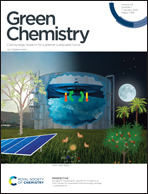A porous thienyl cyclodextrin polymer synthesized in a homogeneous ionic liquid catalytic system for the rapid removal of pharmaceuticals and personal care products (PPCPs)†
Abstract
Pharmaceuticals and personal care products (PPCPs) are widely distributed in aquatic environments due to their large consumption and low biodegradability, causing ecological risks. In this study, a porous thienyl cyclodextrin polymer (Th-CDP) with a specific surface area of 730 m2 g−1 was synthesized in an ionic liquid system for the first time to remove PPCPs. The green and recyclable 1-ethyl-3-methylimidazolium chloride/ferric chloride ([EMIm]Cl/FeCl3) ionic liquid was synthesized as a solvent and catalyst, superior to traditional toxic organic solvents and heterogeneous catalysts. In Th-CDP synthesis, thienyl cyclodextrin (ThCD) was synthesized, followed by polymerization with the three-dimensional cross-linking agent trimethyl orthoformate (Tmof) in [EMIm]Cl/FeCl3via the Friedel–Crafts alkylation reaction. Th-CDP shows excellent adsorption towards the studied PPCPs (diclofenac, ibuprofen, carbamazepine, and sulfamethoxazole) due to the rich pore structure. In particular, Th-CDP achieved 90% removal of hydrophobic diclofenac and ibuprofen in 5 min, and the rate constants were 16.7 and 10.5 times higher than those of activated carbon, respectively. The adsorption capacity of Th-CDP is related to the molecular weight and pKa of the compound, and is about twice that of activated carbon. Th-CDP has more pronounced adsorption advantages over activated carbon for acidic compounds due to its positive charge under neutral conditions. In addition, multiple mechanisms, including hydrophobic interaction caused by thiophene and cyclodextrin, electrostatic interaction, and heteroatom interaction (24.8% S content), enable Th-CDP to efficiently remove PPCPs. Moreover, Th-CDP has great application potential due to its excellent regenerability, anti-interference ability, and green synthesis process.



 Please wait while we load your content...
Please wait while we load your content...